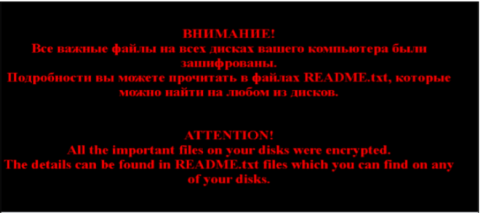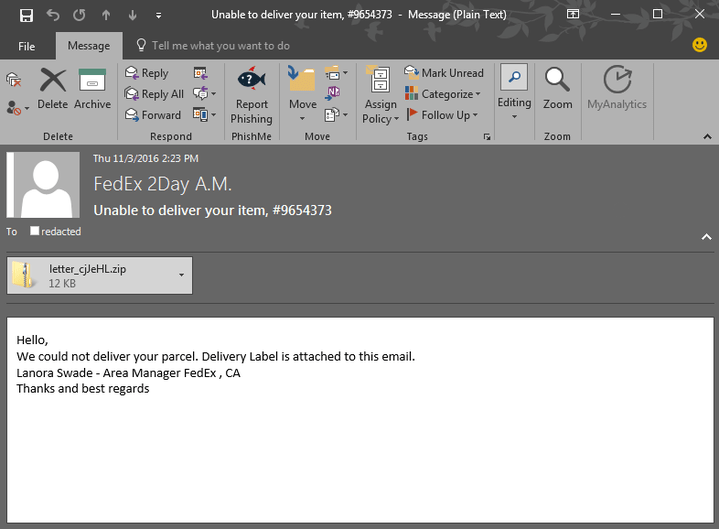As the public becomes more and more aware of ransomware threats through journalistic outlets and the advice of security professionals, threat actors face more challenges in successfully monetizing the deployment of their tools. The longevity of ransomware as a viable criminal enterprise relies upon the continued innovation that ensures threat actors can deliver and monetize infected machines. Much of the innovation seen in 2016 was focused on defying the expectations for how ransomware is delivered such as steganographic embedding of ransomware binaries, other forms of file obfuscation, and requirements for command line argumentation. These were all put forward as ways to ensure victims are infected by the ransomware and put into a position where they may be compelled to pay the ransom and thereby monetize the infection for the threat actor.
While it is easy to be caught up in hype regarding the smallest alteration to ransomware behavior, sometimes a step back and a look at the ransomware business model is more helpful. While the alteration in the extension given to files encrypted by Locky may be easy fodder for blog posts, changes like the addition of the “.shit” extension is likely little more than a jab at information security researchers who have placed a significant amount of stock in the extension applied to encrypted files. Simply put—changing the file extension used by this malware doesn’t fundamentally change how the malware impacts victims. And most victims probably don’t care what extension is applied to their now-inaccessible documents. Most importantly, it does not impact how the threat actor intends to generate revenue from that new infection.
Many of the changes seen in ransomware delivery through 2016 have supported the core of the business model by guaranteeing the maximal number of infections. Innovative means of bypassing controls, frustrating analysis, and creating difficulties for incident response were all created by defying certain expectations. These were all put forward as ways to ensure victims are infected by the ransomware and put into a position where they may be compelled to pay the ransom and thereby monetize the infection for the threat actor. However, as the public becomes more and more aware of ransomware threats through journalistic outlets and the advice of security professionals, threat actors face more challenges in successfully monetizing the deployment of their tools. The longevity of ransomware as a viable criminal enterprise relies upon the continued innovation that ensures threat actors can deliver and monetize infected machines.
One arena in which few ransomware developers have made forays is the capability to repurpose infected machines for other criminal endeavors. Widespread usage of ransomware as a first-step utility is still uncommon among the most prominent ransomware varieties as is the side-by-side delivery of other malware utilities via phishing email. However, this capability would be a simple addition to most ransomware varieties and would stand to create new and virtually-unlimited additional avenues for further monetization of infected machines beyond the collection of a ransom payment. One ransomware variety that has already begun to incorporate this functionality into its behavior is the Troldesh encryption ransomware.

An example of this ransomware was recently analyzed and was found to also deliver a content management system (CMS) login brute-force malware in addition to its core ransomware payload. This malware is designed to force its way into content management systems like WordPress and Joomla by guessing the login credentials. This is valuable to threat actors as it allows them to compromise those websites for any number of reasons including the posting of new malware payloads to be downloaded in later campaigns. Beyond giving threat actors access to the compromised websites, this malware also pushes the responsibility for those compromises away from the threat actor, giving them some level of deniability and distance from the attacks. However, the victim, whose computer is now being used to launch brute-force attacks on websites, must still pay the demanded ransom to regain access to the files that have been encrypted by Troldesh.
However, Troldesh is a ransomware that has a relatively low profile among ransomware varieties—especially in terms of its impact on English-speaking populations. However, another example was identified more recently that indicates that this one-two punch technique is also being used in conjunction with the Locky encryption ransomware—a malware that has a far wider reach and is more well-known.
A set of emails was found to deliver the Locky encryption ransomware alongside the Kovter malware. This pairing is notable as it represents an interesting set of malware utilities delivered to victims. In this case, the Kovter trojan allows the threat actor to maintain access and potentially deliver other malware to machines while also monetizing the infection through click-fraud activities. The messages analyzed by PhishMe Intelligence claimed to deliver a notification regarding the status of a package shipped via FedEx. The JavaScript application attached to these emails was designed to facilitate the download of both a Locky encryption ransomware binary and the additional Kovter sample. This setup harnesses the most successful ransomware of 2016 to provide a short path to financial gains while also including the ability for the threat actor to perform reconnaissance and perhaps even maintain access to the infected environment for extended periods of time.

However, repurposing a victim’s computer to carry out the activities highlighted in these examples are just two examples of what a threat actor could do if additional malware or capabilities are incorporated into ransomware samples. Two factors could make a scenario like this have a significant impact on an individual or company. First, if a threat actor can place a ransomware sample within an environment and then expand their reach using additional malware samples, the threat actor has created two avenues for victimizing that individual or organization. The ransomware is most obvious component of this scenario, but the additional malware sample could be used for a much longer and more damaging operation with implications reaching far beyond the ransomware incident. Secondly, since the expectation is that the ransomware sample is the only avenue for monetization and the only malware involved in most ransomware incidents, an individual or organization may not seek out the additional malware and instead address only the obvious threat instead of the quieter and more longitudinal threat.
The prospect of ransomware featuring additional capabilities or acting as malware downloaders is troubling. It greatly complicates the threat landscape and adds burdens to information security professionals tasked with protecting organizations from both ransomware and other malware utilities. The good news, however, is that many organizations are already aware and empowered to address both ransomware and non-ransomware malware threats. Phishing email has been the most prominent avenue for the delivery of both these categories of malware utility and is an arena where organizations can form holistic defense plans. Holistic phishing defense includes the education and empowerment of all email users to identify and report phishing emails before engaging with the malware they deliver. The information security professionals within those organizations can then utilize that internal intelligence from user reports along with external intelligence to best identify and respond to not just the obvious threats like ransomware, but also the quieter and less-obvious malware threats as well.
The full report on this Troldesh sample used to deliver additional malware payloads is available to PhishMe Intelligence users here. The list below includes a number of IOCs related to this analysis.
JavaScript email attachment:
7bce43f183ea15474f31544713c6edbc
Payload location:
phuketfreeday[.]com/resource/images/flags/oble5/par/systemdll[.]exe
Troldesh binary:
62b4d2fa7d3281486836385bd3f6cd02
Troldesh command and control host:
a4ad4ip2xzclh6fd[.]onion
Content Management System Brute-force bot executable:
7f2c0adb3ead048b6a4512b2495f5e43
Content Management System Brute-force bot command and control host:
x4ethdcumddzwbxc[.]onion
The Locky and Kovter samples are described in this Active Threat Report and related IOCs are listed below.
Locky encryption ransomware sample:
f3d935f9884cb0dc8c9f22b44129a356
Locky hardcoded C2 locations:
hxxp://176.103.56[.]119/message.php
hxxp://109.234.35[.]230/message.php
Kovter sample:
0d01517ad68b4abacb2dce5b8a3bd1d0
Kovter command and control resource:
hxxp://185.117.72[.]90/upload.php
Curious to learn more about our ransomware findings? Check out our Q2 Malware Review where we identified key trends in malware and ransomware in the threat landscape.


